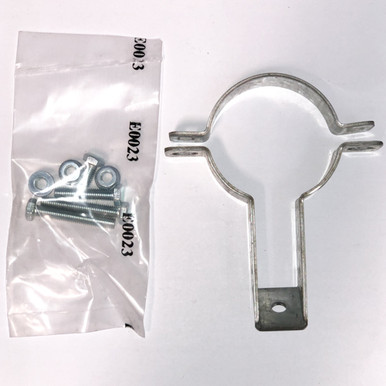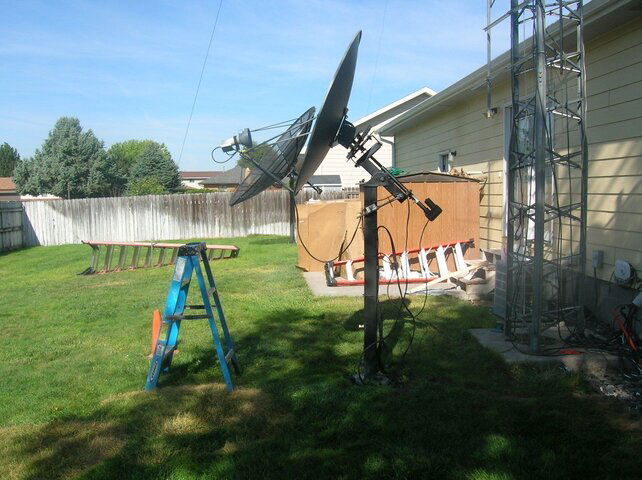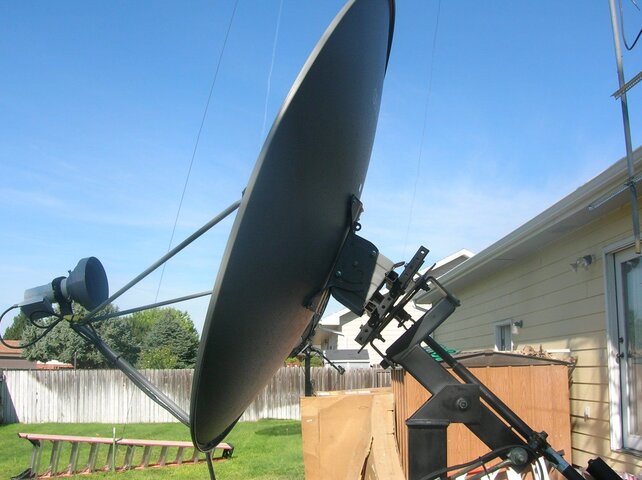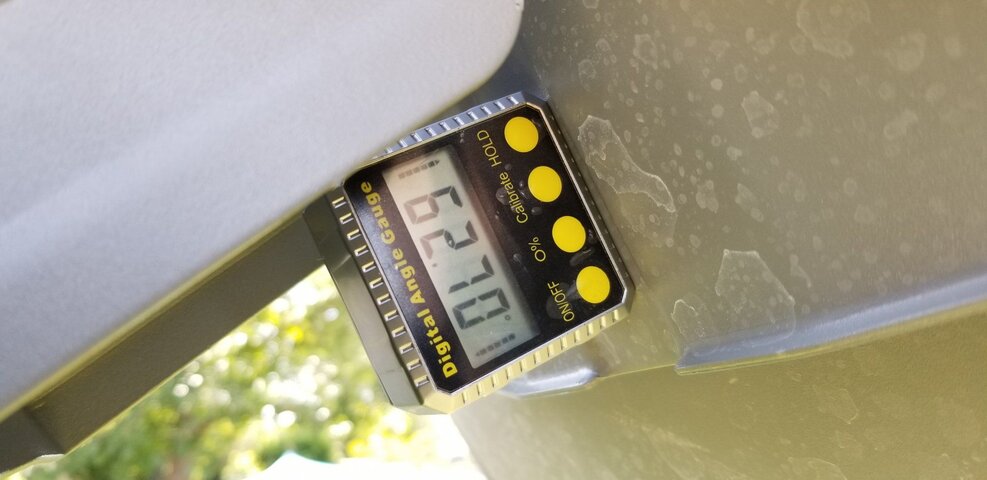I got my GeoSatPro 1.2 meter the other day. Looks OK. I didn't know that it came with a Ku LNBF. Anyway, my plan is to modify the Paraclipse polar mount so that I can put this dish on it. It took quite a bit of effort to fabricate something but I'm ready to mount the dish. I'm going to put a C-band LNBF on it and if it works out I'll be making it the wife's dish. If not, I'll be going to plan B and install the TEK 12 footer on that pole. Two of the 12 footer panels have damage but it's too late to get replacement panels since I didn't inspect and report right away. I "guess" the UPS guy didn't see the "Fragile" labels all over the box. My son said the UPS guy carried both boxes in by himself instead of getting help. I wasn't home at the time. The panels should've been packaged better anyway - there wasn't any kind of packaging to cushion the panels. I plan to put the dish up eventually but only if I can repair the damage to the panels. If I have to buy new panels it'll probably sit around collecting dust - because of CV-19 I might not be able to get replacement panels anyway. Anyway, I should have the 1.2 meter online tomorrow. The only question I have about it is the orientation of the elevation bracket for the antenna. The instructions says to attach it one of two ways depending on whether you use an HH motor. Since I'm going to be using an actuator should it be mounted as if I'm using an HH motor? I guess it doesn't matter as long as I can get the antenna on target.
new 1.2 meter dish and 12 footer
- Thread starter WhiteBeard
- Start date
- Latest activity Latest activity:
- Replies 250
- Views 29K
You are using an out of date browser. It may not display this or other websites correctly.
You should upgrade or use an alternative browser.
You should upgrade or use an alternative browser.
As you're not doing a "normal" installation those instructions don't apply. Mount the bracket so you can adjust it to get the 27.2 degrees (or whatever it is) to compensate for the offset of the dish.
In other words adjust the dish 27.2 from the Paraclypse plate.
In other words adjust the dish 27.2 from the Paraclypse plate.
I thought the correct bracket to hold the C-band LNBF on the offset dish was supplied with the CS-1 conical scalar?
Sent from my SM-G950W using the SatelliteGuys app!
Sent from my SM-G950W using the SatelliteGuys app!
According to Amazon, there was a plastic clamp and a metallic clamp. If there was a metallic clamp in the box then I lost it.
Saw the title and thought for a minute of the FatAir Combo.


The bracket for the GSP 1.2m dish is available from SatelliteAV. I think it's $5. I don't remember it coming with the scaler kit- I had to order it from them.

CLAMP - C-BAND LNBF MOUNTING BRACKET FOR OFFSET DISH
SatelliteAV, LLC provides top quality receivers and encoders for Satellite and Internet distribution.
"... Includes dish mounting bracket & all hardware ..."
Doesn't apply to the GSP 1.2m- he needs the one in post #8
The bracket for the GSP 1.2m dish is available from SatelliteAV. I think it's $5. I don't remember it coming with the scaler kit- I had to order it from them.
It's $10 + $14.50 for shipping at SatelliteAV. I saved $7.50 by buying elsewhere. I probably won't get it until next Saturday (if I'm lucky). Anyway, the metallic bracket that is shown for the CS1 kit looks like the one I need but I can't remember if I ever got it. I did get the plastic bracket that's shown in the ad though. I assume that both styles of bracket were suppose to be included in the kit.
The CS-1 is shipped with the universal poly bracket as described in the product description. No metal bracket has ever been sold or included with the CS1.
The metal bracket sold by Satellite AV is manufactured specifically for their GSP 1.2M.
The metal bracket sold by Satellite AV is manufactured specifically for their GSP 1.2M.
This is good. johnnynobody has an issue, but I won't since I don't have a GSP dish.The CS-1 is shipped with the universal poly bracket as described in the product description.....
OK. I guess Amazon doesn't have their info correct. I was going to show a link to the Amazon ad but I guess that's taboo here. But if you go to their ad for the CS1 and take a peek at the bottom 2 thumbnails you'll see that it's implied that it comes with the metallic bracket as well as the plastic bracket.
While waiting for the LNB mount, I'm wondering if my math is correct. My polar mount main axis angle is 42.7, the declination is 5.8, and the offset dish angle is 27.3. If I understand correctly, the offset dish elevation scale should be set for 42.7+5.8-27.3 which is 21.2 degrees. If it's suppose to be set at 42.7-5.8-27.3 (9.6 degrees) then I have a problem since the scale only goes as low as 15 degrees which means I would need to add more declination? From additional reading, it's possible that I should set the offset dish elevation scale to 25.8 (90-42.7+5.8-27.3). The 90-42.7+5.8 seems to be what a crank arm would be on a HH motor (depending on how you measure the angle on the bent pipe). I'll need to do more research unless someone can clear this up for me.
If I'm correct, can the offset angle be measured with an inclinometer on the offset dish elevation bracket? Just trying to get it right or as close to right (ballpark) so I can get a satellite as quickly as possible. I'll have to figure out which transponders are the strongest on 103W C-band. I'm in the center of the footprint for most of the signals (40+ dBW).
If I'm correct, can the offset angle be measured with an inclinometer on the offset dish elevation bracket? Just trying to get it right or as close to right (ballpark) so I can get a satellite as quickly as possible. I'll have to figure out which transponders are the strongest on 103W C-band. I'm in the center of the footprint for most of the signals (40+ dBW).
Last edited:
While waiting for the LNB mount, I'm wondering if my math is correct. My polar mount main axis angle is 42.7, the declination is 5.8, and the offset dish angle is 27.3. If I understand correctly, the offset dish elevation scale should be set for 42.7+5.8-27.3 which is 21.2 degrees. If it's suppose to be set at 42.7-5.8-27.3 (9.6 degrees) then I have a problem since the scale only goes as low as 15 degrees which means I would need to add more declination? From additional reading, it's possible that I should set the offset dish elevation scale to 25.8 (90-42.7+5.8-27.3). The 90-42.7+5.8 seems to be what a crank arm would be on a HH motor (depending on how you measure the angle on the bent pipe). I'll need to do more research unless someone can clear this up for me.
If I'm correct, can the offset angle be measured with an inclinometer on the offset dish elevation bracket? Just trying to get it right or as close to right (ballpark) so I can get a satellite as quickly as possible. I'll have to figure out which transponders are the strongest on 103W C-band. I'm in the center of the footprint for most of the signals (40+ dBW).
And there was some other info that says to put an inclinometer on the back of the offset dish and set the dish elevation to 14.3 degrees for 103W (41.6-27.3). 41.6 is the look angle for 103W where I'm located and then 27.3 is the dish offset angle. As previously mentioned, the elevation bracket only goes as low as 15 degrees. This info seems to be just for a fixed dish on a particular satellite but it still illustrates the problem with setting up the dish. Should I set the elevation for 25.8 or 14.3? Still researching......
You're overthinking again.
Think of the mount plate as 0,tilt dish out 27.3 from that.
Just an example,if the plate is 100 degrees make the dish 127.3.
If you have an electronic inclinometer,put it on the plate,zero it,move it to the dish mount and set dish to 27.3.
Okay really bad drawing,but,

Think of the mount plate as 0,tilt dish out 27.3 from that.
Just an example,if the plate is 100 degrees make the dish 127.3.
If you have an electronic inclinometer,put it on the plate,zero it,move it to the dish mount and set dish to 27.3.
Okay really bad drawing,but,
While waiting for the LNB mount, I'm wondering if my math is correct. My polar mount main axis angle is 42.7, the declination is 5.8, and the offset dish angle is 27.3. If I understand correctly, the offset dish elevation scale should be set for 42.7+5.8-27.3 which is 21.2 degrees.
Do I understand right that you want to mount the dish bracket directly at the rotating axis?
When modified latitude is 42.7, modified axis elevation is 47.3 degrees.
Needed total elevation due south is 5.8 degrees lower, so 41.5 degrees. That would be the scale setting for a fixed pole (plumb).
Now the rotation axis has already an elevation angle of 47.3, as opposed to plumb. That means the elevation scale should read minus 5.8 degrees.
(Notice that that is logical: declination offset angle always means: needed dish aiming angle, measured from the rotation axis.)
Offset angle is and should always be incorporated in the scale values!....
Didn't someone already mention, that you would probably need an "extra" declination construction, for putting an offset dish directly at a polar mount?
(I've lost the overview over your topics...)
Greetz,
A33
Do I understand right that you want to mount the dish bracket directly at the rotating axis?
Yes. Well, not exactly directly since I used punched square tube to attach the dish elevation bracket to the polar mount (to use the existing holes in the polar mount). See attached photos.
When modified latitude is 42.7, modified axis elevation is 47.3 degrees.
Needed total elevation due south is 5.8 degrees lower, so 41.5 degrees. That would be the scale setting for a fixed pole (plumb).
Now the rotation axis has already an elevation angle of 47.3, as opposed to plumb. That means the elevation scale should read minus 5.8 degrees.
(Notice that that is logical: declination offset angle always means: needed dish aiming angle, measured from the rotation axis.)
The one on the elevation bracket? It would be impossible to get -5.8 degrees with this bracket.
Offset angle is and should always be incorporated in the scale values!....
Didn't someone already mention, that you would probably need an "extra" declination construction, for putting an offset dish directly at a polar mount?
(I've lost the overview over your topics...)
I was hoping that I could use the dish elevation bracket to get the declination that I need but I had to come up with another idea. See the attached photos of the installation. It's still a work in progress to get what I need and without resorting to welding and with minimal materials. I'm using methods that I'm familiar with. I did create a declination rod of sorts but you'll probably have to zoom in to see it. Anyway, the digital inclinometer is showing 62.7 degrees but I believe that has to be subtracted from 90 which results in an angle of 27.3 degrees. I'm assuming that the dish is aligned somewhere in the ballpark.
Attachments
Needed total elevation due south is 5.8 degrees lower, so 41.5 degrees.
So, when measured at the vertical dish face, subtract the offset angle of 27.3 (as per your information), to get the dish face elevation angle of 14.2 degrees (just 14.2 degrees from vertical).
So I guess the dish has to lean forward a little bit more.
Greetz,
A33
Similar threads
- Replies
- 4
- Views
- 818
- Replies
- 9
- Views
- 995
- Replies
- 4
- Views
- 2K
- Replies
- 6
- Views
- 645
Users Who Are Viewing This Thread (Total: 0, Members: 0, Guests: 0)
Who Read This Thread (Total Members: 13)
Latest posts
-
TLosing Your Digital Life With Apple in a Snap
- Latest: TWiT Tech Podcast Network
-
-




